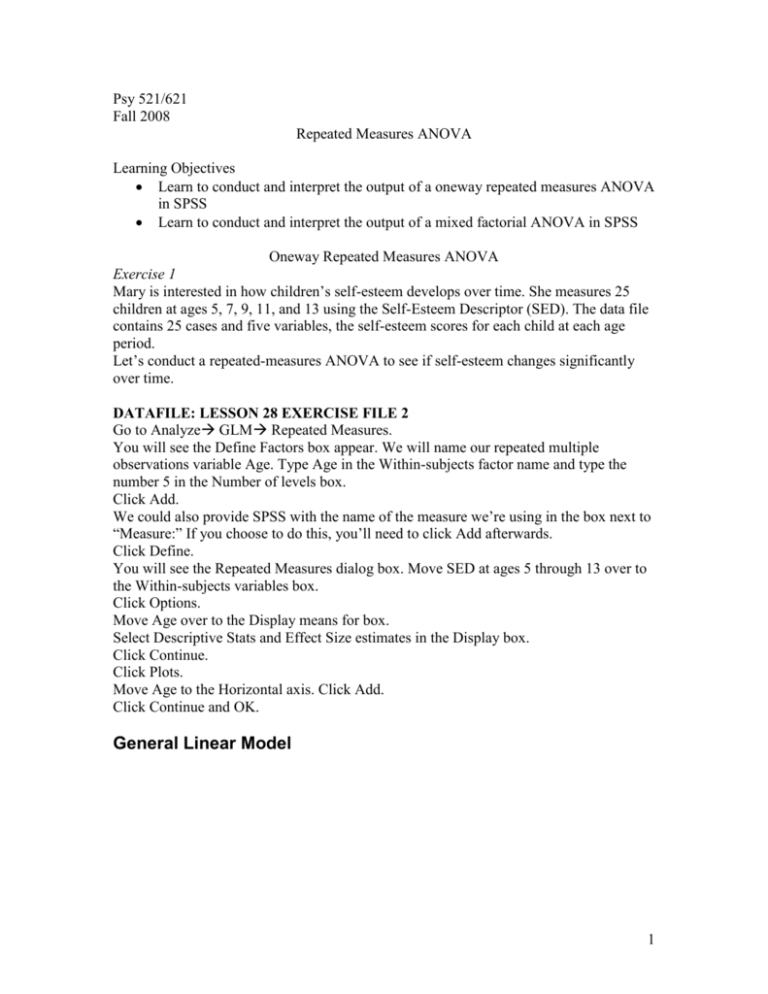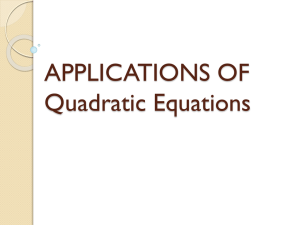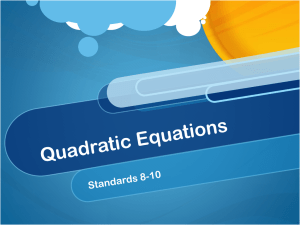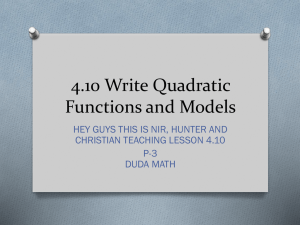Lab 9 activities
advertisement

Psy 521/621 Fall 2008 Repeated Measures ANOVA Learning Objectives Learn to conduct and interpret the output of a oneway repeated measures ANOVA in SPSS Learn to conduct and interpret the output of a mixed factorial ANOVA in SPSS Oneway Repeated Measures ANOVA Exercise 1 Mary is interested in how children’s self-esteem develops over time. She measures 25 children at ages 5, 7, 9, 11, and 13 using the Self-Esteem Descriptor (SED). The data file contains 25 cases and five variables, the self-esteem scores for each child at each age period. Let’s conduct a repeated-measures ANOVA to see if self-esteem changes significantly over time. DATAFILE: LESSON 28 EXERCISE FILE 2 Go to Analyze GLM Repeated Measures. You will see the Define Factors box appear. We will name our repeated multiple observations variable Age. Type Age in the Within-subjects factor name and type the number 5 in the Number of levels box. Click Add. We could also provide SPSS with the name of the measure we’re using in the box next to “Measure:” If you choose to do this, you’ll need to click Add afterwards. Click Define. You will see the Repeated Measures dialog box. Move SED at ages 5 through 13 over to the Within-subjects variables box. Click Options. Move Age over to the Display means for box. Select Descriptive Stats and Effect Size estimates in the Display box. Click Continue. Click Plots. Move Age to the Horizontal axis. Click Add. Click Continue and OK. General Linear Model 1 Within-Subjects Factors Measure: MEASURE_1 Dependent Variable sed1 sed2 sed3 sed4 sed5 age 1 2 3 4 5 De scriptive Statistics Self-es teem Self es teem Self-es teem Self-es teem Self-es teem at at at at at age age age age age 5 7 9 11 13 Mean 33.88 27.60 29.60 29.96 16.08 St d. Deviation 27.917 35.352 31.492 34.863 16.951 N 25 25 25 25 25 Multivaria te Testsb Effect age Pillai's Trac e W ilks' Lambda Hotelling's Trac e Roy's Largest Root Value .555 .445 1.247 1.247 F Hy pothesis df 6.549a 4.000 6.549a 4.000 a 6.549 4.000 6.549a 4.000 Error df 21.000 21.000 21.000 21.000 Sig. .001 .001 .001 .001 Partial Eta Squared .555 .555 .555 .555 a. Ex act statistic b. Design: Int ercept W ithin Subject s Design: age b Ma uchly's Test of Spheri city Measure: MEA SURE_1 a Epsilon W ithin Subject s Effect Mauchly's W age .470 Approx . Chi-Square 16.945 df 9 Sig. .050 Greenhous e-Geis ser .747 Huynh-Feldt .865 Lower-bound .250 Tests the null hypothes is that t he error covariance matrix of the orthonormalized transformed dependent variables is proportional to an ident ity matrix. a. May be us ed t o adjust the degrees of freedom for the averaged t ests of s ignificance. Corrected tests are displayed in the Tests of W ithin-Subject s Effect s table. b. Design: Int ercept W ithin Subject s Design: age 2 Tests of Within-Subjects Effects Measure: MEASURE_1 Source age Error(age) Type III Sum of Squares 4539.088 4539.088 4539.088 4539.088 22834.512 22834.512 22834.512 22834.512 Sphericity Assumed Greenhous e-Geisser Huynh-Feldt Lower-bound Sphericity Assumed Greenhous e-Geisser Huynh-Feldt Lower-bound df 4 2.989 3.461 1.000 96 71.727 83.058 24.000 Mean Square 1134.772 1518.796 1311.589 4539.088 237.859 318.355 274.922 951.438 F 4.771 4.771 4.771 4.771 Sig. .001 .004 .003 .039 Partial Eta Squared .166 .166 .166 .166 Te sts of Betwe en-Subjects Effects Measure: MEASURE_1 Transformed Variable: Average Source Int ercept Error Ty pe III Sum of Squares 94009. 472 85732. 928 df 1 24 Mean Square 94009. 472 3572.205 F 26.317 Sig. .000 Partial Eta Squared .523 Estimated Marginal Means age Measure: MEASURE_1 age 1 2 3 4 5 Mean 33.880 27.600 29.600 29.960 16.080 Std. Error 5.583 7.070 6.298 6.973 3.390 95% Confidence Interval Lower Bound Upper Bound 22.356 45.404 13.007 42.193 16.601 42.599 15.569 44.351 9.083 23.077 Profile Plots Estimated Marginal Means of MEASURE_1 Estimated Marginal Means 35 30 25 20 15 1 2 3 4 5 age As the omnibus ANOVA is significant, we will conduct two types of follow-up tests: 1) a polynomial contrast: set as a default in SPSS, so we don’t have to ask for them 3 *Note: polynomial contrasts are most appropriate when the variable is continuous in nature (e.g., time). 2) a Fisher’s LSD test: Click Options, move “age” into the “Display means for” window and below that window check the box next to “compare main effects.” LSD is the default, but you can use the drop down menu to see what your other options are (i.e., Bonferroni & Sidak) *Note: we will run these contrasts for pedagogical purposes, but interpretation of the contrasts are more meaningful since the variable (age) is truly continuous Tests of Within-Subjects Contrasts Measure: MEASURE_1 Source age Error(age) age Linear Quadratic Cubic Order 4 Linear Quadratic Cubic Order 4 Type III Sum of Squares 2762.244 506.403 1267.876 2.565 6235.456 9469.383 2524.424 4605.249 df 1 1 1 1 24 24 24 24 Mean Square 2762.244 506.403 1267.876 2.565 259.811 394.558 105.184 191.885 F 10.632 1.283 12.054 .013 Sig. .003 .268 .002 .909 Partial Eta Squared .307 .051 .334 .001 (see Howell p. 677 for the polynomial coefficients) 4 Pairwise Comparisons Measure: MEASURE_1 (I) age 1 2 3 4 5 (J) age 2 3 4 5 1 3 4 5 1 2 4 5 1 2 3 5 1 2 3 4 Mean Difference (I-J) 6.280 4.280 3.920 17.800* -6.280 -2.000 -2.360 11.520* -4.280 2.000 -.360 13.520* -3.920 2.360 .360 13.880* -17.800* -11.520* -13.520* -13.880* Std. Error 3.662 4.574 4.509 4.148 3.662 3.827 3.464 5.533 4.574 3.827 3.513 4.780 4.509 3.464 3.513 5.097 4.148 5.533 4.780 5.097 a Sig. .099 .359 .393 .000 .099 .606 .502 .048 .359 .606 .919 .009 .393 .502 .919 .012 .000 .048 .009 .012 95% Confidence Interval for a Difference Lower Bound Upper Bound -1.278 13.838 -5.160 13.720 -5.387 13.227 9.240 26.360 -13.838 1.278 -9.898 5.898 -9.508 4.788 .101 22.939 -13.720 5.160 -5.898 9.898 -7.611 6.891 3.655 23.385 -13.227 5.387 -4.788 9.508 -6.891 7.611 3.361 24.399 -26.360 -9.240 -22.939 -.101 -23.385 -3.655 -24.399 -3.361 Based on estimated marginal means *. The mean difference is s ignificant at the .05 level. a. Adjustment for multiple comparisons: Leas t Significant Difference (equivalent to no adjustments). We can see from the post hoc analyses that self-esteem at age thirteen is significantly lower than self-esteem at ages 5, 7, 9, and 11. Ages 5, 7, 9, and 11 do not differ from one another is a systematic manner. APA results: A one-way within-subjects analysis of variance was conducted to determine whether self-esteem changes significantly as children develop. The factor, age, had five levels (5, 7, 9, 11, and 13), the dependent variable was scores on the Self-Esteem Descriptor (SED) with higher scores indicating higher self-esteem. Twenty-five children participated in the study over eight years. Mauchly’s test was significant, therefore sphericity was not assumed and the Greenhouse-Geisser correction was employed. The results indicate a significant age effect on self-esteem, F(3, 72) = 4.77, p < .05, partial η2 = .17. Follow-up polynomial contrasts indicate significant linear and cubic trends, F(1, 24) = 10.63, p = .003, partial η2= .31 and F(1, 24) = 12.05, p < .05, partial η2= .33, 5 respectively. [The linear trend suggests that mean self-esteem scores decrease with age: 5 (M = 33.88, SD = 27.92), 7 (M = 27.60, SD = 35.35), 9 (M = 29.60, SD = 31.49), 11 (M = 29.96, SD = 34.86), and 13 (M = 16.08, SD = 16.95). The cubic trend suggests that selfesteem at age 5 is the highest and self-esteem at age 13 is the lowest, while self-esteem at ages 7, 9, and 11 is moderate and does not change across this intermediate time period. FYI: if you were comparing treatment types (i.e., categories) rather than trends in age or time, you would report post hoc analyses. Below is an example of the followup portion of the APA section for a post hoc situation. Follow-up post hoc analyses were conducted using Fisher’s LSD. The results indicate that average self-esteem scores at age 13 (M = 16.08, SD = 16.95) are significantly lower than average self-esteem scores at ages 5 (M = 33.88, SD = 27.92), 7 (M = 27.60, SD = 35.35), 9 (M = 29.60, SD = 31.49), and 11 (M = 29.96, SD = 34.86). Self-esteem at ages 5, 7, 9, and 11 did not differ from one another is a systematic manner. Mixed Factorial ANOVA Exercise 2 A researcher wants to study a phenomenon in memory and learning research called proactive interference. Proactive interference occurs when you attempt to learn new information and previously learned information interferes with the new material. For the experiment, the researcher had the participants complete a series of trials. On each trial, the researcher presented the participant with a short list of words whose meanings are highly related (e.g., names of flowers). After seeing the words, the participant then had to recall the words in the list. For the experimental and control groups, to which participants were randomly assigned, the first three trials used the same category of words. On the fourth trial, the researcher changed the meaning of the words for the experimental group (e.g., names of professions rather than names of flowers), but left the meaning of the words for the control group unchanged. Do we understand why this is a mixed factorial design? What is the within subjects factor? Trials: it is a within subjects factor because each participant participates in every trial. What is the between subjects factor? Experimental group (experimental or control) is the between subjects factor because a participants are in either the experimental or control group, not both. Let’s draw out, conceptually, how we are going to partition the variance in this model: TOTAL VARIATION Between subjects Group (G) Errorbetween (SS w/in groups) Within subjects Trial (T) TXG Errorwithin (T X SS w/in groups) 6 Let’s conduct a mixed factorial ANOVA to see if differences in scores across trials differ for the experimental group vs. the control group (i.e., depending on experimental condition). DATAFILE: PROACTIVE.SAV Go to Analyze GLM Repeated Measures. You will see the Define Factors box appear. We will name our repeated multiple observations variable Trial. Type Trial in the Within-subjects factor name and type the number 4 in the Number of levels box. Why do we enter a 4 here? Click Add. Click Define. You will see the Repeated Measures dialog box. Move trial 1 through 4 over to the Within-subjects variables box. Move Group to the Between-subjects factors box. Click Options. Move group, trial, and group*trial over to the Display means for box. Select Descriptive Stats, Effect Size estimates, and Homogeneity test in the Display box. Click Continue. Click Plots. Move Trial to the Horizontal axis and Group to the Separate lines box. Click Add. Click Continue and OK. Even though this info shows up near the end in the output, let’s look at the plot we created first to get a visual understanding of what’s happening with our data. Profile Plots Estimated Marginal Means of MEASURE_1 Experimental Condition 80.00 Experimental Estimated Marginal Means Control 70.00 60.00 50.00 40.00 30.00 1 2 3 4 trial 7 Our between subjects factor (group) is being represented by the lines (blue for exp. green for control). Our within subjects factor is represented on the horizontal axis. What seems to be happening? Let’s think first in terms of main effects: Trial: It seems as though participant memory is declining across trials, although (averaging across conditions) it seems to turn upward a bit on Trial 4. To get an idea of this main effect we are looking at the average of the two groups at each trial (e.g., average the two dots for Trial 1, average the two dots for Trial 2, etc, then compare the 4 values. If they are the same, the main effect for trial is probably not significant). Group: Probably not a main effect here, but it is a little difficult to tell from the graph. To get an idea of this main effect we are comparing the average memory score across trials for each group (e.g., create an average of all of the dots on the blue line, create an average of all the dots on the green line, then compare the two. If they are the same, the main effect for group is probably not significant) Would you guess that there is a group X trial interaction? Likely so because of the relatively extreme differences in the values for the exp. vs. control groups in the 4th trial. General Linear Model Within-Subjects Factors Measure: MEASURE_1 trial 1 2 3 4 Dependent Variable trial1 trial2 trial3 trial4 Between-Subjects Factors Experimental Condition 1.00 2.00 Value Label Experiment al Control N 5 5 8 Descriptive Statistics Trial 1 Memory Trial 2 Memory Trial 3 Memory Trial 4 Memory Experimental Condition Experimental Control Total Experimental Control Total Experimental Control Total Experimental Control Total Mean 78.0000 77.2000 77.6000 50.2000 58.6000 54.4000 38.2000 43.2000 40.7000 64.8000 35.8000 50.3000 Std. Deviation 10.55936 8.81476 9.17969 5.93296 11.92896 9.92416 16.42255 8.16701 12.50822 9.88433 9.31128 17.76420 N 5 5 10 5 5 10 5 5 10 5 5 10 a Box's Test of Equality of Covaria nce Ma trice s Box's M F df1 df2 Sig. 20.805 .894 10 305.976 .539 Tests the null hypothes is that t he observed covariance matric es of the dependent variables are equal acros s groups . a. Design: Int ercept+group W ithin Subject s Design: trial Multivaria te Testsb Effect trial trial * group Pillai's Trac e W ilks' Lambda Hotelling's Trac e Roy's Largest Root Pillai's Trac e W ilks' Lambda Hotelling's Trac e Roy's Largest Root Value .922 .078 11.847 11.847 .811 .189 4.288 4.288 F Hy pothesis df 23.694 a 3.000 23.694 a 3.000 23.694 a 3.000 23.694 a 3.000 8.575a 3.000 8.575a 3.000 8.575a 3.000 8.575a 3.000 Error df 6.000 6.000 6.000 6.000 6.000 6.000 6.000 6.000 Sig. .001 .001 .001 .001 .014 .014 .014 .014 Partial Eta Squared .922 .922 .922 .922 .811 .811 .811 .811 a. Ex act stat istic b. Design: Int ercept+group W ithin Subject s Design: trial 9 b Ma uchly's Test of Spheri city Measure: MEA SURE_1 a Epsilon W ithin Subject s Effect Mauchly's W trial .856 Approx . Chi-Square 1.045 df 5 Sig. .959 Greenhous e-Geis ser .908 Huynh-Feldt 1.000 Lower-bound .333 Tests the null hypothes is that t he error covariance matrix of the orthonormalized transformed dependent variables is proportional to an ident ity matrix. a. May be us ed t o adjust the degrees of freedom for the averaged t ests of s ignificance. Corrected tests are displayed in the Tests of W ithin-Subject s Effect s table. b. Design: Int ercept+group W ithin Subject s Design: trial Mauchly’s test is ns, so we don’t have to worry about violating the sphericity assumption. Te sts of W ithi n-Subje cts Effe cts Measure: MEA SURE_1 Source trial trial * group Error(t rial) Sphericity Ass umed Greenhous e-Geiss er Huynh-Feldt Lower-bound Sphericity Ass umed Greenhous e-Geiss er Huynh-Feldt Lower-bound Sphericity Ass umed Greenhous e-Geiss er Huynh-Feldt Lower-bound Ty pe III Sum of Squares 7354.500 7354.500 7354.500 7354.500 2174.900 2174.900 2174.900 2174.900 1952.600 1952.600 1952.600 1952.600 df 3 2.723 3.000 1.000 3 2.723 3.000 1.000 24 21.785 24.000 8.000 Mean Square 2451.500 2700.734 2451.500 7354.500 724.967 798.671 724.967 2174.900 81.358 89.630 81.358 244.075 F 30.132 30.132 30.132 30.132 8.911 8.911 8.911 8.911 Sig. .000 .000 .000 .001 .000 .001 .000 .017 Partial Eta Squared .790 .790 .790 .790 .527 .527 .527 .527 Note that you have an error term here. On the diagram on p. 451 this is referred to as: “I x Ss w/in groups” We have significant main effects for trial, and for the trialXgroup interaction. This is what we suspected based on the plot. 10 Tests of Within-Subjects Contrasts Measure: MEASURE_1 Source trial trial * group Error(trial) trial Linear Quadratic Cubic Linear Quadratic Cubic Linear Quadratic Cubic Type III Sum of Squares 4569.680 2689.600 95.220 968.000 1166.400 40.500 451.720 887.000 613.880 df 1 1 1 1 1 1 8 8 8 Mean Square 4569.680 2689.600 95.220 968.000 1166.400 40.500 56.465 110.875 76.735 F 80.929 24.258 1.241 17.143 10.520 .528 Sig. .000 .001 .298 .003 .012 .488 Partial Eta Squared .910 .752 .134 .682 .568 .062 Significant linear and quadratic trends exist for the trial main effect and the trialXgroup interaction. This shouldn’t be surprising based on what we saw in the plot. In considering the linear and quadratic trends for the main effect of trial, we saw that, averaging across groups, scores tended to decline across trials (linear trend) until the 4th trial when there was a slight improvement (quadratic trend). How do we interpret the significant linear and quadratic trends for the trialXgroup interaction? Well, this basically means that the linear/quadratic trend depends on the group you are in. Focusing on the significant linear trend, it seems that the pattern displayed by the control group is driving the interaction, i.e., the trend seems to be linear for the control group, but not the experimental group. Now focusing on the significant quadratic trend, it seems that the pattern displayed by the experimental group is driving, i.e., the trend is quadratic for the experimental group, but not the control. a Le vene's Test of Equa lity of Error Va riances Trial Trial Trial Trial 1 2 3 4 Memory Memory Memory Memory F .070 3.933 .987 .000 df1 df2 1 1 1 1 8 8 8 8 Sig. .798 .083 .350 1.000 Tests the null hypothes is that t he error variance of the dependent variable is equal ac ross groups. a. Design: Int ercept+group W ithin Subject s Design: trial 11 Tests of Between-Subjects Effects Measure: MEASURE_1 Transformed Variable: Average Source Intercept group Error Type III Sum of Squares 124322.500 168.100 1597.400 df 1 1 8 Mean Square 124322.500 168.100 199.675 F 622.624 .842 Sig. .000 .386 Partial Eta Squared .987 .095 This is the main effect for group: as you can see it is ns. Again, this is what we expected based on our plots. And you have another error term here. On the diagram on p. 451 this is referred to as: “Ss w/in groups.” So you now have TWO error terms: one for the within subjects effect, and one for the between subjects effect. Estimated Marginal Means 1. Experimental Condition Measure: MEASURE_1 Experimental Condition Experimental Control Mean 57.800 53.700 Std. Error 3.160 3.160 95% Confidence Interval Lower Bound Upper Bound 50.514 65.086 46.414 60.986 2. trial Measure: MEA SURE_1 trial 1 2 3 4 Mean 77.600 54.400 40.700 50.300 St d. E rror 3.076 2.979 4.101 3.036 95% Confidenc e Int erval Lower Bound Upper Bound 70.507 84.693 47.530 61.270 31.243 50.157 43.298 57.302 3. Experim ental Condition * trial Measure: MEASURE_1 Ex perimental Condition trial Ex perimental 1 2 3 4 Control 1 2 3 4 Mean 78.000 50.200 38.200 64.800 77.200 58.600 43.200 35.800 St d. Error 4.350 4.213 5.800 4.294 4.350 4.213 5.800 4.294 95% Confidenc e Interval Lower Bound Upper Bound 67.970 88.030 40.485 59.915 24.825 51.575 54.898 74.702 67.170 87.230 48.885 68.315 29.825 56.575 25.898 45.702 12 Here’s a summary of what we know so far: Main effect for group is not significant: F(1, 8) = .84, p > .05, partial η2 =.10. Averaging over trial, there are no significant differences in recall between treatment and control groups. Main effect for trial is significant: F(3, 24) = 30.12, p < .05, partial η2 = .79. Averaging over experimental condition, there are significant differences in trial recall scores. Polynomial contrasts for the main effect: there is a significant linear relationship, F(1,8) = 80.93, p < .05, partial η2 = .91, such that, averaging across experimental condition, the average number of correctly recalled words tends to decrease over time (across trials). There is also a significant quadratic relationship, F(1,8) = 24.26, p <.05, partial η2 =.75), such that, averaging over experimental condition, the average number of correctly recalled words tends to be greater in the first and last trials, and fewer in the intermediate trials. Interaction between experimental condition and trial is significant: F(3, 24) = 8.91, p < .05, partial η2 = .53. Differences in experimental conditions depend on which trial is considered. Additionally, differences in the linear decrease and the quadratic trend found across trials depend on which experimental condition is considered. Looking at the plot above, it looks as though there is a linear decrease for the control group and a quadratic trend for the experimental group. Creating L-scores and Q-scores Let’s compare the linear and quadratic trends across experimental groups: First we will create L-scores. Go to Transformcompute. Type in Lscore for the Target variable name. Enter the following equation into the numeric expression box: (3 * trial1) + (1 * trial2) + (-1 * trial3) + (-3 * trial4). While we’re here, let’s go ahead and create Q-scores because we know that we want to examine the significant quadratic trend. Type in Qscore for the Target variable name. Enter the following equation into the numeric expression box: (1 * trial1) + (-1* trial2) + (-1* trial3) + (1 * trial4) and press continue. **Note: this is a great example of a time when you would want to save your syntax. You will likely want to track how you created these lscores and qscores (i.e., what coefficients you used). Click the Paste button after you’ve entered in the relevant information to start that syntax file.** Here is the syntax for what we just did: COMPUTE lscore = (3 * trial1) + (1 * trial2) + (-1 * trial3) + (-3 * trial4) . EXECUTE . COMPUTE qscore = (1 * trial1) + (-1 * trial2) + (-1 * trial3) + (1 * trial4) . EXECUTE . Let’s think about what these variables that we just created mean. L-scores: strength of the linear decrease for each subject. High l-scores indicate a strong linear decrease, relatively smaller l-scores indicate that the linear decrease is not as strong. Q-scores: strength of the quadratic trend, more specifically a u-shaped quadratic trend. Higher scores indicate a stronger quadratic trend, smaller scores indicate a weaker quadratic trend. 13 We’ll first analyze the difference in the linear trend across the groups (conditions). Go to Analyzecompare meansone-way ANOVA. Move Lscore over to DV and experimental condition over to Factor. Chose Options and select Homogeneity and Descriptives. Chose Contrasts and select Polynomial. Enter 1 and -1 for experimental and control, respectively. Oneway [DataSet1] C:\Documents and Settings\Elizabeth 621 TA\Week 9\proactive.sav McCune\My Documents\PSY Descriptives lscore N Experimental Control Total 5 5 10 Mean 51.6000 139.6000 95.6000 Std. Deviation 40.61157 24.68400 56.16879 Std. Error 18.16205 11.03902 17.76213 95% Confidence Interval for Mean Lower Bound Upper Bound 1.1741 102.0259 108.9508 170.2492 55.4193 135.7807 Minimum 9.00 113.00 9.00 Maximum 108.00 166.00 166.00 Test of Homogeneity of Variances lscore Levene Statistic 1.322 df1 df2 1 8 Sig. .283 ANOVA lscore Between Groups (Combined) Linear Term Contrast Within Groups Total Sum of Squares 19360.000 19360.000 9034.400 28394.400 df 1 1 8 9 Mean Square 19360.000 19360.000 1129.300 F 17.143 17.143 Sig. .003 .003 Contra st Coefficie nts Contrast 1 Ex perimental Condition Ex perimental Control 1 -1 Contrast Tests lscore As sume equal variances Does not assume equal variances Contrast 1 1 Value of Contrast -88.0000 -88.0000 Std. Error 21.25371 21.25371 t -4.140 -4.140 df 8 6.601 Sig. (2-tailed) .003 .005 14 You can see that there is a significant difference in the linear trend between the two groups. The average linear decrease in number of correctly recalled words for the control group (M = 139, SD = 24.68) is significantly steeper than the average linear decrease in number of correctly recalled words for the experimental group (M = 51.60, SD = 40.61), t(8) = 4.14, p < .05. Now let’s analyze the difference in the quadratic trend across the experimental conditions. Go to Analyzecompare meansone-way ANOVA. Move Qscore over to DV and experimental condition over to Factor. Chose Options and select Homogeneity and Descriptives. Choose Contrasts and select Polynomial. Enter 1 and -1 for experimental and control, respectively. Click Continue and OK. Oneway Descriptives Qs core N Experim ental Control Total 5 5 10 Mean 54.4000 11.2000 32.8000 Std. Deviation 11.92896 27.28919 30.20964 Std. Error 5.33479 12.20410 9.55313 95% Confidence Interval for Mean Lower Bound Upper Bound 39.5882 69.2118 -22.6840 45.0840 11.1893 54.4107 Minimum 39.00 -31.00 -31.00 Maximum 64.00 45.00 64.00 Test of Homogeneity of Variances Qs core Levene Statistic .657 df1 df2 1 Sig. .441 8 ANOVA Qs core Between Groups (Combined) Linear Term Contrast Wi thin Groups Total Sum of Squares 4665.600 4665.600 3548.000 8213.600 df 1 1 8 9 Mean Square 4665.600 4665.600 443.500 F 10.520 10.520 Sig. .012 .012 Contra st Coefficie nts Contrast 1 Ex perimental Condition Ex perimental Control 1 -1 Contrast Tests Qs core As sume equal variances Does not as sume equal variances Contrast 1 1 Value of Contrast 43.2000 43.2000 Std. Error 13.31916 13.31916 t 3.243 3.243 df 8 5.475 Sig. (2-tailed) .012 .020 You can see that there is a significant difference in the quadratic trend between the two groups. The quadratic trend is significantly greater for the experimental group (M = 15 54.40, SD = 11.93) than for the control group (M = 11.20, SD = 27.29), t(8) = 3.24, p < .05. APA Write-up: A 2 x 4 mixed factorial ANOVA was conducted in order to determine the effect of proactive interference on recall across trials (the within subjects factor with four levels). Ten participants completed a series of trials. On each trial, participants were presented a short list of words whose meanings are highly related (e.g., names of flowers). After seeing the words, the participant must then recalled the words in the list. For the experimental (n = 5) and control groups (n = 5), to which participants were randomly assigned, the first three trials used the same category of words. On the fourth trial, the meaning of the words was changed for the experimental group (e.g., names of professions rather than names of flowers), but the meaning of the words did not change for the control group. The main effect for experimental condition was not significant, F(1, 8) = .84, p > .05, partial η2 =.10. The main effect for trial was significant, F(3, 24) = 30.12, p < .05, partial η2 = .79; averaging over experimental condition, there were significant differences in trial scores. Follow-up polynomial contrasts indicated that there was a significant linear relationship, F(1, 8) = 80.93, p < .05, partial η2 = .91, such that, averaging over experimental condition, the average number of correctly recalled words tended to decrease across trials. There was also a significant quadratic relationship, F(1, 8) = 24.26, p <.05, partial η2 =.75), such that, averaging over experimental condition, the average number of correctly recalled words tended to be greater in the first and last trials, and fewer in the intermediate trials. However, the main effects must be qualified due to the significant interaction between experimental condition and trial, F(3, 24) = 8.91, p < .05, partial η2 = .53. Contrast analyses indicated that the linear trend was significantly different for the experimental and control groups. The average linear decrease in number of correctly recalled words for the control group (M = 139.00, SD = 24.68) was significantly stronger than the average linear decrease in number of correctly recalled words for the experimental group (M = 51.60, SD = 40.61), t(8) = 4.14, p < .05. The quadratic trend also differed significantly for the experimental and control groups. The quadratic trend was significantly greater for the experimental group (M = 54.40, SD = 11.93) than for the control group (M = 11.20, SD = 27.29), t(8) = 3.24, p < .05. 16








